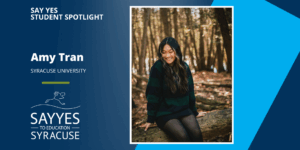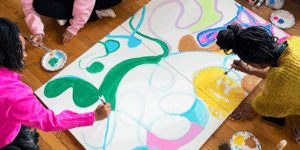*If you have a questions regarding wild animal rescue, please contact the Charles N. Gordon Wildlife Rehabilitation Center at 315-273-7227 or visit www.gordonwildlife.org to learn more.*
“The simple truth, the REAL answer as to why I devote every waking hour, every dollar, and every dream to their future and well-being is this: raccoons are magical,” said Sarah Bookbinder.
Bookbinder, a Class II RVS-licensed wildlife rehabilitator, and her husband Paul, a board-certified veterinary surgeon, were always known as “the animal people” in their community. So it was no surprise when, in 2017, a neighbor reached out to them after finding two orphaned baby raccoons on the side of the road.
The pair immediately fell in love with the raccoons, a species Bookbinder described as “often undervalued”. They were able to keep them temporarily under her husband’s veterinary license, but struggled to find medical guidance to provide proper care. Sadly, both babies died in the end.
“We didn’t know much about wildlife rehabilitation at the time so we started calling around but we couldn’t find a rehabber anywhere in the state who could take them,” said Bookbinder. “The few people licensed to treat raccoons were full and there was no one to help.”
Realizing the need for additional resources for raccoons, Bookbinder channeled her love for the species into co-founding the Charles N. Gordon Wildlife Center with her husband in 2018. Through the Center, located in Earlville, NY, the pair rehabilitates raccoons across Central New York.
 The center specializes in providing immediate veterinary care, rehabilitation services and shelter for injured or sick raccoons until they are deemed healthy enough to be released back into the wild. Bookbinder and her team also educate the community, offering training and resources to help people better understand the primarily nocturnal animal that plays a crucial role in the ecosystem.
The center specializes in providing immediate veterinary care, rehabilitation services and shelter for injured or sick raccoons until they are deemed healthy enough to be released back into the wild. Bookbinder and her team also educate the community, offering training and resources to help people better understand the primarily nocturnal animal that plays a crucial role in the ecosystem.
“Many people think that if they see a raccoon during the day, it’s rabid,” Bookbinder explained. “They don’t realize that there are many perfectly normal reasons for raccoons to be out during the day, particularly in the spring. Mothers leave the dens to feed themselves during the day so that they are home to protect the babies at night.”
Raccoons, she adds, play an important role in seed dispersal, which promotes the growth of diverse plant communities. They also help control populations of small rodents and insects, contributing to ecosystem balance.
Bookbinder noted that one of her biggest challenges is that while people often understand the importance of rehabilitation for animals, they tend to focus on domestic animals like cats and dogs. This makes funding for wildlife rehabilitation, particularly for raccoons, harder to secure. She aims to educate and dispel the misconception that raccoons don’t need veterinary care when they’ve become injured.
“Convincing people that raccoons matter isn’t always easy,” she said. “We believe that ecosystem preservation and environmental education begins at home. It is important to protect our local native species and raccoons make excellent educational ambassadors, and people can learn about protecting the wildlife right in their backyard.”

Despite dealing with compassion fatigue and burnout—emotional challenges common in rehabilitation work—Bookbinder remains committed to advancing her medical offerings for raccoons. She emphasizes the importance of using radiographs, produced by X-ray machines, as a diagnostic tool for quickly assessing the extent of internal injuries. But without an X-ray machine or advanced medical equipment of her own, Bookbinder had to transport raccoons to a secondary rehabber facility for higher levels of care.
“Wild animals like raccoons are easily stressed, so being able to quickly and accurately diagnose injuries is key to providing effective treatment,” she explained. “Having to transport heavily injured raccoons for proper treatment became increasingly disruptive to their well-being.”

In February 2022, the center acquired a singlewide trailer, positioned half a mile from the main rehabilitation center, to serve as an in-house wildlife medical facility. Thanks to a $10,000 grant from the Dr. Robert J. Vitkus Fund at the Community Foundation, the center purchased an X-ray machine, one of the first pieces of equipment for the new medical facility.
“Having our own X-ray machine is just the start,” said Bookbinder. “We’re working toward a fully equipped medical facility, complete with hospital flooring, an incubator, ICU oxygen casings, and other resources to ensure the safety of our native wildlife,” she said.
Since being installed in the X-ray machine has been used to treat numerous raccoons being rehabilitated at the center in addition to animals under the care of other rehabilitators across New York State. To date, Bookbinder and her team have helped rehabilitate animals from Broome, Cayuga, Chemung, Chenango, Cortland, Delaware, Dutchess and Erie counties and beyond.
With high hopes for a safe future for both the environment and the wildlife within it, the Charles N. Gordon Wildlife Center remains dedicated to its mission and strives to inspire others to join in their efforts.
Bookbinder explained that the experience of finding an animal, learning about what caused its crisis and the process of trying to help it, can often have a profound and meaningful impact on what rehabilitators refer to as “the finders.”
“Finders become personally invested in saving the animals,” she said. “We have seen their whole world views be transformed by this small act of kindness, trying to help and save one animal. The conversations and connections that grow out of that experience are like no other.”









